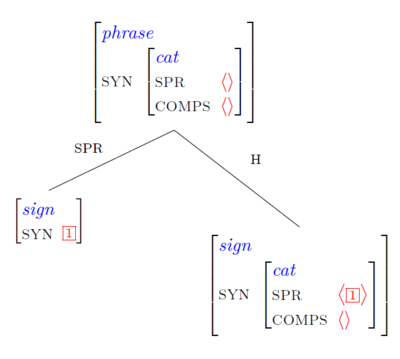Syntax 1 Wiki: Week 4
Looking under the hood
Exercise
Go to the Online Grammar and do the following:
- Type "snores" into the Sentence textbox and press the "Parse" button or RETURN on your keyboard.
- Click once on the top node of the tree.
- Inspect the result and try to understand as much as possible.
Now click on the boxed "0" after AGR.
- Inspect the result and try to understand as much as possible.
Finally, click on the boxed number below the NP in the SPR list.
- Again, inspect the result and try to understand as much as possible.
Click on the new boxed "0" after the AGR that appears.
- Now there are two boxed "0"s on the screen. What seems to be their function?
Exercise
Go to the Online Grammar and do the following:
- Parse the sentence Lilly dances".
- Open the S node and the V node. Don't open any numbered boxes for now.
- Compare the two feature structures.
- For every feature (= attribute), compare the values of mother and daughter.
- Now open the N node, leaving its numbered boxes alone again.
- Compare the three feature structures. What relationships do you detect? Do the self-test exercises below.
Self-test exercises
(1) The part of speech features of the mother are also the part of speech features of
Check your answer
the verb.
(2) The verb is looking for ______ complements.
Check your answer
no
(3) The sentence is looking for ______ complement(s).
Check your answer
no
(4) The verb is looking for ______ specifier(s).
Check your answer
one
(5) If the verb requires a specifier, then it selects a specifier of part of speech ________.
Check your answer
NP
(6) The sentence is looking for ______ specifiers.
Check your answer
no
(7) Formulate the relationship between the valences of S and V, and the relationship between the NP daughter and the V daughter.
Check your answer
A. The verb is complement-empty and selects one NP-specifier.
B. The NP acts as the verb's specifier.
C. As the verb's specifier requirement has now been satisfied, its mother S has an empty SPR list (as well as an empty COMPS list).
Head-Specifier Phrases
We can combine all the observations above into a Phrase Structure Rule. In short form, the rule can be formulated as follows:
(1) XP -> Specifier X
We call this kind of phrase a head-specifier phrase.
Instead of formulating the full-fledged PS rule, we look directly at the local tree that the rule licenses:
A head-specifier phrase can be formed by combining a sign [= the head daughter] with a second sign [= the non-head daughter] whose syntactic category can be unified with the syntactic category on the word’s SPR list.
Comparing the tree in the online grammar with the tree above (the rule), you will notice that they aren't completely identical.
(1) What does the rule contain that is missing from the tree?
Check your answer
The rule marks the righthand daughter as the head(= H) and the lefthand daughter as a specifier (= SPR).
(2) What does the tree contain that is missing from the rule?
Check your answer
The tree contains the information that the mother node and the head have the same part of speech features.
